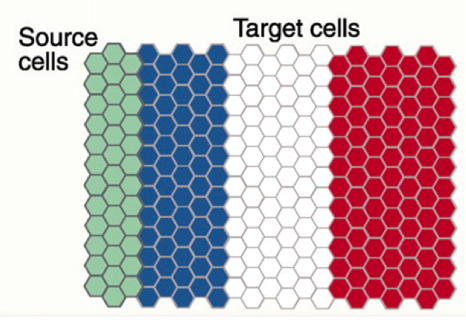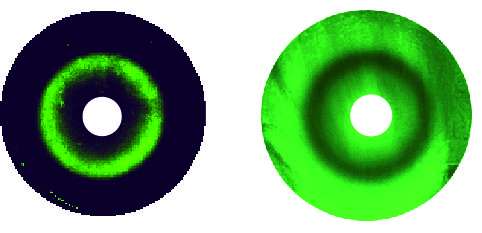Recreating the stripe patterns found in animals by engineering synthetic gene networks

Pattern formation is essential in the development of animals and plants. The central problem in pattern formation is how can genetic information be translated in a reliable manner to give specific spatial patterns of cellular differentiation.
The French-flag model of stripe formation is a classic paradigm in developmental biology. Cell differentiation, represented by the different colours of the French flag, is caused by a gradient of a signalling molecule (morphogen); i.e. at high, middle or low concentrations of the morphogen a "blue", "white" or "red" gene stripe is activated, respectively. How cellular gene regulatory networks (GRNs) respond to the morphogen, in a concentration-dependent manner, is a pivotal question in developmental biology. Synthetic biology is a promising new tool to study the function and properties of gene regulatory networks (GRNs) by building them from first principles. This study developed synthetic biology methods to build some of the fundamental mechanisms behind stripe formation.
In previous studies, gene circuits with predefined behaviors have been successfully built and modeled, but mostly on a case-by-case basis. In this study published in Nature Communications, researchers from the EMBL/CRG Systems Biology Research Unit at the CRG, went beyond individual networks and explored both computational and synthetic mechanisms for a complete set of 3-node stripe-forming networks in Escherichia coli. The approach combined experimental synthetic biology led by Mark Isalan, now Reader in Gene Network Engineering at the Department of Life Sciences of Imperial College London with computational modelling led by James Sharpe, ICREA Research Professor and head of the Multicellular Systems Biology lab at the CRG.
"We have performed a very innovative and ambitious study: we applied a three-step approach for the effective exploration and creation of successful synthetic gene circuits. We created a theoretical framework to study the GRNs exhaustively" - 100,000 versions of over 2800 networks were simulated on the computer. We then successfully developed a synthetic network engineering system and, finally, we confirmed all the new experimental data by fitting it to a single mathematical model" explains the corresponding author James Sharpe.

First, Andreea Munteanu, co-author of the study, performed a theoretical screen for finding all design classes that produce the desired behaviour (stripe formation in a morphogen gradient). During this step she discovered four fundamentally-different mechanisms for forming a stripe. Next, Yolanda Schaerli, first author of the study, successfully demonstrated that the four networks are functional by building them in the bacteria E. coli using the tools of synthetic biology. The third step was to verify the distinct mechanisms by fitting all the experimental data to a mathematical model.
The success of this procedure allowed the researchers to go one step further to find a deeper design principle of stripe formation. They identified a simpler 2-node network – where the stripe gene is directly controlled by both activation and repression from the morphogen sensor gene– that replicates the stripe-forming ability in its simplest form. They were successful in building this archetype of stripe forming networks and ultimately discovered that it can even display an "anti-stripe" phenotype (fig. 2, bacterial lawns).
"Combining exhaustive computational modeling with synthetic biology is more efficient and powerful than building networks one-by-one" says the corresponding author Mark Isalan. "Our approach provides a new and efficient recipe for synthetic biology - a new scientific discipline which aims to engineer all kinds of useful biological systems"
Journal information: Nature Communications
Provided by Center for Genomic Regulation


















